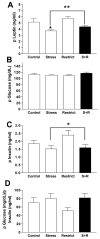Body composition and endocrine status of long-term stress-induced binge-eating rats
- PMID: 17498757
- PMCID: PMC1989154
- DOI: 10.1016/j.physbeh.2007.04.001
Body composition and endocrine status of long-term stress-induced binge-eating rats
Abstract
Clinical binge eating runs a protracted course. The etiology of binge eating remains perplexing in part because, in humans, it is difficult to isolate and assess the independent and aggregate impact of various contributing variables. Using rats, we found that footshock stress and a history of caloric restriction (S+R), combine synergistically to induce binge eating. Stress and dieting are also strong antecedents and relapse factors in human eating disorders. Here we report further behavioral and physiological parallels to human binge eating. Like the protracted course of human binge eating, young female Sprague-Dawley rats continued to binge eat after 23 restriction/stress cycles (7 months) and this despite experiencing no significant weight loss during the restriction phases. Stress alone reduced adiposity by 35% (p<0.001) but S+R rats had no significant fat loss. An endocrine profile of normal plasma leptin and insulin levels but marked elevation of plasma corticosterone levels was found only in the binge-eating (S+R) rats (p<0.01), also paralleling endocrine profiles reported in clinical binge-eating studies. These behavioral and physiological similarities between this animal model and clinical binge eating increase its utility in understanding binge eating. Importantly, our findings also highlight the stubborn nature of binge eating: once a critical experience with dieting and stress is experienced, little if any further weight loss or food restriction is necessary to sustain it.
Figures




Similar articles
-
The biology of binge eating.Appetite. 2009 Jun;52(3):545-553. doi: 10.1016/j.appet.2009.03.005. Epub 2009 Mar 20. Appetite. 2009. PMID: 19501749 Free PMC article. Review.
-
A new animal model of binge eating: key synergistic role of past caloric restriction and stress.Physiol Behav. 2002 Sep;77(1):45-54. doi: 10.1016/s0031-9384(02)00809-0. Physiol Behav. 2002. PMID: 12213501
-
Binge eating in rats produced by combining dieting with stress.Curr Protoc Neurosci. 2006 Aug;Chapter 9:Unit9.23A. doi: 10.1002/0471142301.ns0923as36. Curr Protoc Neurosci. 2006. PMID: 18428649
-
Combined dieting and stress evoke exaggerated responses to opioids in binge-eating rats.Behav Neurosci. 2005 Oct;119(5):1207-14. doi: 10.1037/0735-7044.119.5.1207. Behav Neurosci. 2005. PMID: 16300427
-
Does severe dietary energy restriction increase binge eating in overweight or obese individuals? A systematic review.Obes Rev. 2015 Aug;16(8):652-65. doi: 10.1111/obr.12295. Epub 2015 Jun 11. Obes Rev. 2015. PMID: 26094791
Cited by
-
The biology of binge eating.Appetite. 2009 Jun;52(3):545-553. doi: 10.1016/j.appet.2009.03.005. Epub 2009 Mar 20. Appetite. 2009. PMID: 19501749 Free PMC article. Review.
-
Ten putative contributors to the obesity epidemic.Crit Rev Food Sci Nutr. 2009 Nov;49(10):868-913. doi: 10.1080/10408390903372599. Crit Rev Food Sci Nutr. 2009. PMID: 19960394 Free PMC article. Review.
-
Sleep disturbances and binge eating disorder symptoms during and after pregnancy.Sleep. 2012 Oct 1;35(10):1403-11. doi: 10.5665/sleep.2124. Sleep. 2012. PMID: 23024439 Free PMC article.
-
Binge eating and psychostimulant addiction.World J Psychiatry. 2021 Sep 19;11(9):517-529. doi: 10.5498/wjp.v11.i9.517. eCollection 2021 Sep 19. World J Psychiatry. 2021. PMID: 34631457 Free PMC article. Review.
-
The mindful moms training: development of a mindfulness-based intervention to reduce stress and overeating during pregnancy.BMC Pregnancy Childbirth. 2018 Jun 1;18(1):201. doi: 10.1186/s12884-018-1757-6. BMC Pregnancy Childbirth. 2018. PMID: 29859038 Free PMC article.
References
-
- American Psychiatric Association. Diagnostic and Statistical Manual of Mental Disorders, IV-TR. Washington, DC: APA; 2000.
-
- Yanovski SZ. Binge eating disorder: current knowledge and future directions. Obes Res. 1993;1:306–324. - PubMed
-
- Hagan MM, Shuman ES, Oswald KD, Corcoran KJ, Profitt JH, Blackburn K, Schwiebert MW, Chandler PC, Birbaum C. Incidence of chaotic eating behaviors in binge-eating disorder: Contributing factors. Behav Med. 2002;28:99–105. - PubMed
-
- Crowther JH, Sanftner J, Bonifazi DZ, Shepherd KL. The role of daily hassles in binge eating. Int J Eat Disorders. 2001;29:449–454. - PubMed
-
- Heatherton TF, Baumeister RF. Binge eating as escape from self-awareness. Psych Bull. 1991;119:86–108. - PubMed
Publication types
MeSH terms
Substances
Grants and funding
LinkOut - more resources
Full Text Sources

